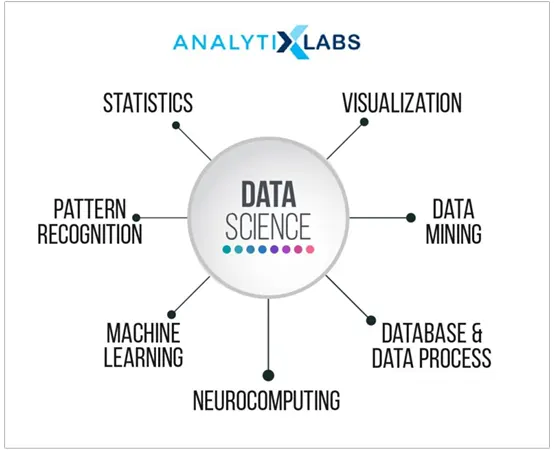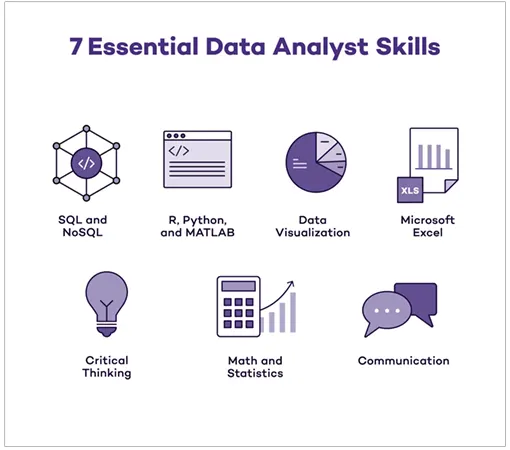
Are you also confused between the job titles, data science and data analytics? Do you want to know more about these job titles?
If yes, then you are in the right place. In this article, we’ll discuss both the fields, while shedding light on the differences between the two.
People often mix up these professions due to the similar terms, but it means different things, even if they’re connected. Both fields turn raw numbers into useful insights, but they do this in their own ways and for different reasons.
There are many misconceptions in the sector because there are many different perceptions of the responsibilities and qualifications of various positions. The misunderstanding that a data scientist is just a more sophisticated version of a data analyst is a good example of this problem.
Difference between data science and data analytics
Everything we do online—texting, sending emails, social media messaging, sending tweets, etc.—all comes under Big Data. Big data, data analysis, and data science are all tools used to manage the truckload of data the digital world generates every day.
Now, before we dive into the differences, it is vital to know what the two exactly mean.
Data Science

Data science is a field that deals with large sets of unstructured and structured information. It uses calculations, statistics, programming, mathematics, and other sciences to extract valuable information from massive amounts of information that is presented in a variety of formats. examine large amounts of info.
Beyond evaluating to forecast future trends, developing the products, and developing advanced algorithms to solve challenging issues, a data scientist contributes to organisations in many different ways.
Data science is used across many industries that deal with large datasets. Some of these industries are finance, technology, healthcare, pharma, and marketing. All these industries require an extensive amount of information to be combined and examined to get desirable results.
There are many components that make up data sciences, some of the core components are mentioned below:
- Exploratory Data Analysis (EDA): In EDA, you use visual methods to accumulate key features in a dataset. It assists in identifying unusual patterns and connections within the information that point you in the direction of further investigation.
- Data Collection and Preparation: The collected information is usually raw and messy, and it needs to be cleaned and processed for further use.
- Data Visualisation: It simplifies the results of an analysis so that people can understand the complex results without trouble.
- Modeling and Algorithms: With the help of statistics and machine learning, analysts create models to figure and sort out numbers. Advanced algorithms, like decision trees and neural networks, as well as techniques that combine several approaches, are used in data science.
- Deployment and Monitoring: The models are put to use to get real time predictions and results. Data scientists keep an eye on the models to ensure their result accuracy.
Data Analytics

Data analytics work with structured information to draw conclusive results. The main goal here is to handle and analyse existing datasets statistically. Pursuing a master’s in data analytics can significantly enhance these skills, equipping professionals with advanced techniques and tools to excel in the field.
It helps convert large amounts of information into simple English. This benefits a variety of businesses because it enables them to base their judgments on the data’s conclusions.
Data analytics is widely used in different fields, such as Sports, Finance, Health Care, and retail. It analyses information so that industries can use it to make better decisions.
The core components that makeup data analytics are mentioned below:
- Descriptive Analytics: To comprehend what happened previously, this summarises past information. The usual methods include totalling, calculating averages, and identifying patterns or trends.
- Diagnostic analytics: Data analysts dissect information in order to identify causes, connections, and hidden factors explaining past events.
- Predictive Analytics: With the help of machine learning and statistics, data analysts make predictions based on past results.
- Perspective Analytics: Results from the above two analytics are used to propose appropriate actions.
- Reporting and Visualization: Another aspect of data analytics is presenting data information in an understanding manner, frequently using graphs, charts, and dashboards.
Key differences between data sciences and data analytics
Both involve working with large amounts of information, but there are some key differences in the way these two work with data.
- Data Type: Data science uses both unstructured and structured information to draw results. However, data analytics only use structured records.
- Skills: Data sciences require knowledge of statistical skills to better function in the field. However, data analytics does not have any such requirements.
Data Science and data analytics course

Both courses vary as the fields require different sets of skills. It is vital to understand the basic course structure before choosing the field you want to work in.
A data science course involves technical learning. In this, students need to learn programming languages like Python, R, and SQL. Machine learning, statistical analysis, Hadoop and Spark-like big technologies, and Matplotlib tool for visualization, are also part of this course.
In the data analytics course, students learn about the information’s interpretation and analysis. The focus is less on technical learning and more on understanding the existing tools.
Topics on tools like Excel, Tableau, and SQL are covered in the course. It also includes some basic machine-learning techniques and visual reports for information visualization.
Data science vs Data analytics salary
Data scientists take a more technical role in their jobs, while data analysts have a statistical job profile. Both of these are high-paying jobs in the IT industry. Work experience is beneficial in both fields; however, data analytics can be a more entry-level position.
In India, the salary of data scientists can range from 8 lakhs to 10 lakhs per annum, varying based on their work profile and experience. On the other hand, data analyst’s salaries range from 4.5 lakhs to 6 lakhs per annum. Both with positive career growth.
Conclusion
In closing, both are great career options. While many people confuse the two fields, as we mentioned above, there are various key differences between them. Understanding the advantages of these courses can help you take full advantage of the opportunities they present.
FAQs
Ans:
The choice is based on individual preference. If your interest is in machine learning and more technical applications, data science is a better choice. However, if you are more interested in analytics and simpler technical tools, data analysis is a better choice.
Ans: Although it depends on individual skills and interests, data analytics is not harder.
Ans: Data scientists normally earn more money. Salaries vary depending on the individual’s skills and position.
Ans: Yes, data analytics requires some basic coding languages like Python and R.